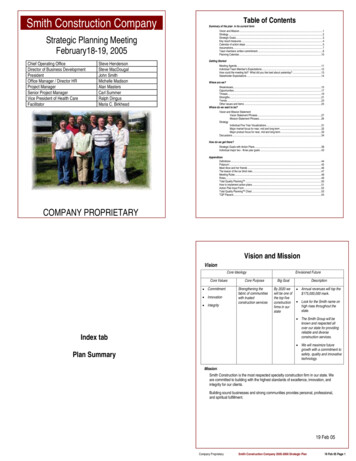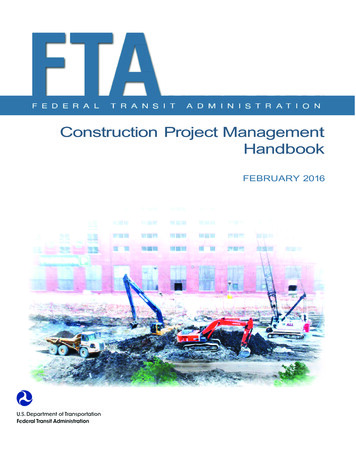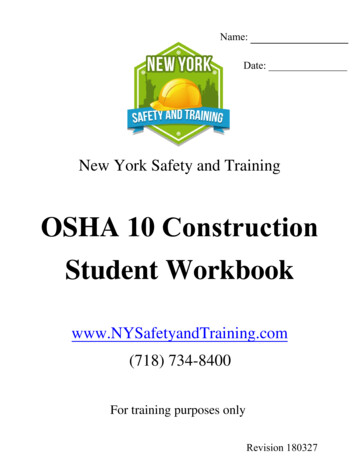
Transcription
Careers in ConstructionInDemandConnecting today’s students with the careers of tomorrowIssue 1A Wealthof CareersOne million jobs willbe added in constructionby 2012. One of themcould be yours!
CareerVoyagesAd.jpg11/3/052:18:43 PMYAGESCAREERVOCMYCMMYCYCMYKCareer Voyages provides information about career options that can help you choose your future andfind education and training opportunities needed to get there.Visit CareerVoyages.gov to find links to job descriptions and job listings in your community.
Dear Student:Do you like to draw or build things? Are you strongin mathematics or science and do you have fun withtechnology? Do you like to help others or enjoyrunning events in school or in your community, andthink you might be good at managing people one day?Assistant SecretaryDeRocco (left) talksconstruction withACE Mentor studentsin St. Louis.No, this isn’t a class quiz but if you answered yes to any or allof these questions this publication is for you! It will tell youall about the construction industry, which might give you anidea for your future career. It talks about what you need tolearn and do to get that first great job. Whether you want tobe an environmental engineer a skilled ironworker ormanager of a skyscraper being built, there are lots of careersin construction that pay well.I’m Emily DeRocco, Assistant Secretary of Labor forEmployment and Training, and I run the federal agency thathelps American workers find rewarding jobs and build successful careers. Since you will soon be part of the workforce,the U.S. Department of Labor’s Employment and TrainingAdministration wants you to have this publication, InDemand-Careers In Construction. It will let you know what thisindustry is all about, and how you can build your future in it.There’s lots of great information in here! Please read it, andshare what you find with your parents, teachers and guidancecounselor. They can help you find the right college or university to study for a construction career, or the right apprentice program to gainskills and job experience!So what’s In Demand? You are! Your knowledge your energy your creativity and your skills are all In Demand—and so are the many high-growth jobsthat you will learn more about in this publication. Also look for future copiesof In Demand that tell you about great careers in fields such as energy. You andyour friends could also visit the web site careervoyages.gov to get electroniccopies of this magazine and to explore all kinds of careers. The sky is the limit!Break new ground Build YOUR future!Emily Stover DeRoccoAssistant Secretary of Laborfor Employment and TrainingIn Demand 1
Contents46How ConstructionInfluences Your LifeEverything man-made hasa construction connection.The places where you live,go to school and go out toeat all had to be constructed.OpportunitiesThe construction industryneeds workers and pays well.The U.S. Dept. of Labor estimates that one million newjobs will be added to the construction industry by 2012.ConstructionIndustry ProfilesPeople join the industry in many ways and have avariety of jobs to pick from. A few tell why they choseconstruction and what they hope for in their ENGINEERELECTRICALWORKER212223How It AllFits TogetherConstruction is a complicated process thatstarts with a projectneed, moves to designby architects and engineers, and construction by builders.2 NWORKERMARKETINGOWNER
InDemandCareers in ConstructionU.S. DEPARTMENT OF LABOREmily Stover DeRoccoGardner CarrickKatherine A. AllenDan AustellRachel CowgillDenise KennedyMonte Lutz26Fun FactsHow high is the tallestbuilding? What’s the longestbridge? What’s the biggestdump truck? .and more.24How Technology Has Changedthe Construction Industry2830ReferencesOn job sites, in architectural and engineeringoffices and in research labs, young people arebeing drawn to the digital revolution.How to contact organizations that can helpyou get started in construction careers.Calling All MentorsThe key to a successful career is to have caringpeople already in the industry showing you theropes and opening doors to opportunity.U.S. Department of LaborInDemand was written and produced by The McGraw-Hill Companies under contractto the U.S. Department of Labor Employment and Training Administration. No officialendorsement by the U.S. Department of Labor of any product, group, commodity,service or enterprise mentioned in this magazine is intended or should be inferred.Cover Illustration by Ron ChanTHE MCGRAW-HILL COMPANIESEDITOR-IN-CHIEFJanice L. TuchmanMANAGING EDITORSJohn J. KosowatzWilliam G. KrizanPUBLICATION DESIGNShostak StudiosAnna Egger-SchlesingerMaritza C. HurtadoSENIOR EDITORSJoann GoncharTimothy J. GroganDebra K. RubinTom SawyerWRITERSAnna AntoniakHousley CarrPam HunterScott LewisCarrie McGourtyTom NicholsonLia SteakleyPHOTO EDITORJackie DiMitriEDITORIAL PRODUCTIONAgnes Barbara B. Montalban-SalvioVirginia J. CamascaSwati ScindiaGOVERNMENT & BUS. DEV. MANAGERJames KerrEDUCATION ADVISORSCharlotte Frank, McGraw-Hill EducationCathy Scruggs, Glencoe/McGraw-HillMANUFACTURING, DISTRIBUTIONMichael VincentTed FreedmanKathy LavelleCIRCULATIONMaurice PersianiFINANCIAL DIRECTORIke B. ChongASSOCIATE PUBLISHERPaul L. BoningtonPUBLISHERMark KellyGROUP EDITORIAL DIRECTORRobert IvyGROUP PUBLISHERJames H. McGraw IVPublished for the U.S. Department ofLabor by McGraw-Hill Construction,Norbert W. Young Jr., FAIA, President; andGlencoe/McGraw-Hill, Steven E. McClung,President. McGraw-Hill Construction andGlencoe are units of The McGraw-HillCompanies.InDemand available oncareervoyages.gov and construction.com
HowEverything man-made has a construcConstructionInfluencesBy Pam HunterYour Lifeext time you are outside, take a lookaround. All of the buildings that wework, live and play in were built by construction industry professionals. Theyhighways4 www.careervoyages.govhousestrial plants or research laboratories.The construction industry can buildbig, like the Empire State Building orHoover Dam. It also can build small,like a house in your neighborhood. Butlarge or small, construction projectsmake a difference in the lives of peoplearound them.New Ball GameTake, for example, the new sports arenafor the Charlotte Bobcats in Charlotte,N.C. The 780,000-sq-ft arena, completed this fall, is home to the NBA’s Charlotte Bobcats and the WNBA’s CharlotteSting. But buildings like this offer more.People can see basketball games in thearena—it seats more than 20,000—butit also offers a stage large enough forPHOTOS BY MICHAEL GOODMANalso built the factories that make our cars, the refineries that produce the gas to fuel them and the roads and bridges we drive on.Ditto for airports, train stations, cell-phone towers, powerplantsand schools. There is very little in our world that is not affected insome way by construction.Construction is the second-largest industry in the nation,employing about 7 million workers. It contributes about 5% of alldomestic U.S. economic activity and accounts for nearly 10% ofall businesses—mostly small, privately owned firms.Construction has been a part of people’s lives since they firstcrawled out of caves many thousandsof years ago. They needed shelters andstructures to shield themselves fromthe elements and slowly developed thetools and the techniques to build whatwas needed.The industry has grown andchanged tremendously over time.Today, construction is not just aboutbricks and mortar and hammers andnails. Contractors use high-tech toolsand machinery to build highly sophisticated facilities such as hospitals, indus-
tion connectionofficesstadiumsStartingOveracts such as Cold Play, Tim McGraw,local high school basketball games andice-skating performances.Such projects can transform entireneighborhoods. San Diegos’ PETCOPark, home to the Padres, has generateda construction boom in a neighborhoodthat previously had deteriorating buildings, warehouses, empty parking lotsand little else. It now is full of life, withnew restaurants, nightclubs, theatersand condominiums. Similar activity istaking place in other neighborhoodsacross the nation.Even works of art are constructed.The new World War II Memorial inWashington, D.C., is visited each year bythousands of veterans and tourists fromaround the world to learn about the war,remember the sacrifices and reflect onthe consequences.And where there are such projects,there is a need for bright, talentedpeople to fill the jobs at architectureand engineering firms and constructioncompanies. The future is bright.Government statistics show that construction is the only goods-producingindustry that can expect to see employment growth in coming years.To be able to walk through your town,city or state and be able to say, “I builtthat,” is a rewarding and even awe-inspiring experience. So the next time you takea walk, look around. Without mucheffort, you will see the results of a lot ofhard work, dedication and inspirationfrom the construction industry.We don’t realize how muchconstruction touches ourlives until a monster likeHurricane Katrina destroyseverything in its path.The storm wrecked275,000 homes on the GulfCoast. Whole towns suddenly were thrust underwater and a way of lifeended. Not only were homesand businesses destroyed,but also facilities for drinking water, wastewater,power and communications. Nothing worked.Cleanup, planning and rebuilding has started, but itwill take years to restore theregion to a level that peoplewould consider “normal.”
PerThe construction industry6 www.careervoyages.gov
ByHousleyCarrThefect TimeTo Startneeds workers and it pays well.PHOTO AT LEFT: TERRY LOWENTHAL /BECHTEL CORPORATION / PHOTO AT RIGHT: PAUL EDMONDSON/GETTY IMAGESou’ve picked the perfect time to think about acareer in construction.You know those moments—a dive into a pool, theswing of a bat, a win in a heated Xbox or PlayStationConstruction issearching foryoung workersto help it buildthe structuresneeded to keepAmerica growing and strong.match—when it all comes together?That’s what’s happening now in the construction industry.Just look around your neighborhood,along the highway, or downtown. There isa lot of construction work going on. Andnot just new houses, but new shopping centers, office buildings, and stadiums. Not to mention all thenew roadwork, the new sewage treatment plants,and the airport terminal expansions.On top of that, the hurricanes of 2005, especiallyKatrina, caused billions of dollars in damage, andrequire tens of thousands of reconstruction andnew-construction projects.All of that work is demanding a lot of workers.Architects and engineers to design what’s beingbuilt. Project managers to oversee the construction.Laborers and skilled craftsmen–carpenters, electricians and plumbers–to do the actual building.Overall, the U.S. Department of Labor estimatesthat one million new jobs will be added to the construction industry by 2012.Luckily for you, this country’s building boom ishappening at a time when there is a real shortage ofconstruction workers. And just like you pay morefor a hot concert ticket, construction companies paymore to find the scarce workers they need.The need for new workers is so great that theconstruction industry itself is working with highschools, community colleges and four-year collegesto encourage students to consider careers in construction, and is providing them with training andsummer-work opportunities.High school and college graduates entering theconstruction industry “can earn very good money,”says Dr. Richard Judy, chief executive officer atWorkforce Associates Inc., Indianapolis, whichIn Demand 7
Average annual salariesfor constructionprofessional staffArchitect 70,280Landscape architect 81,990Architectural/civil drafter 45,290Construction manager 78,290Cost estimator 60,690Engineering manager 90,890Civil engineer 63,560Civil engineeringtechnician 45,990Electrical engineer 79,680Health and safety 59,010engineerMechanical engineer 71,110Mechanical drafter 48,720Environmental engineering 45,980technicianPurchasing manager 79,730Purchasing agent 56,360Surveyor 53,410Surveying technician 30,830Average annual salariesfor skilled craftsBoilermakerBrickmasonCarpenterConcrete finisherDrywall installerElectricianEquipment operatorCrane operatorGlazierPainterPlumberRebar workerSteel worker 49,220 46,530 38,730 35,820 34,010 41,760 42,210 39,660 36,940 33,320 47,190 39,610 40,960WAGES, SALARIES VARY BY REGIONSOURCE: U.S. DEPT. OF LABOR BUREAU OF LABOR STATISTICS8 www.careervoyages.govhelps states develop proproject engineer. A newgrams to attract workershire might make 42,000to construction.to 45,000 the first year.A significant portion ofThe sky’s the limitthe skilled constructionfrom that point on. Knudworkforce is in their 40sHermansen, a professor atand 50s and will be retiringthe University of Maine’sover the next few years, heConstructionsays. But there are nowhereManagement Technologynear enough youngerprogram, said that theworkers to replace them.CMT program not only–Betsy Tondreau“There’s a misconcepsurveys its graduatingtion among a lot ofseniors about the jobsyounger people that conthey take, but about howstruction jobs are hard and dirty, andtheir careers are progressing five and 10that they don’t offer a lot in terms of cayears after they graduate. For the proreer advancement. But that is not thegram’s most recent graduating class, stucase,” says Judy. There are a wide rangedents received an average of about threeof opportunities available in the conjob offers and an average starting salarystruction industry, both for high schoolof just over 42,000. “They stick withgraduates who want to go directly intoconstruction, and have a very high levelthe workforce and learn a trade, andof career satisfaction,” he says.those who want to go on to college.Hermansen says that it is not uncomJudy looks at the big picture. Peoplemon for CMT graduates to see theircloser to the action agree with them,salaries double within seven to 10 years,though. “We are really in a bidding war”and to be earning “six-figure” salaries byfor good workers, says Karen Hall, directhe time they are in their mid-30s.tor of human resources at Flintco, aBetsy Tondreau is a real-life example.company that builds sports facilities,She picked a construction major at theprisons and schools.University of Arizona and was hired by“The opportunities for jobs are unPerini Corp., one of the nation’s largestlimited,” Hall says. “There are all kindsgeneral contractors, after graduating.of positions that are available. And notThirteen years later she is second injust running a jackhammer, but for allcommand on a 450-million hotel/casikinds of skilled and professional jobs.”no project in Las Vegas. “I love it. EveryHall says that to grab the best collegeconstruction job is like a big puzzle. Andstudents graduating from constructionyou work with a great group of peoplerelated programs, Flintco targets a fewto put it together,” Betsy says.students early on, usually in their juniorThe bottom line is that work in theyear. Many companies “may even payconstruction industry is interesting, the[the student’s] tuition the last year orpay is good, and the job security is defitwo” to help ensure the student joinsnitely there with a shot at managementthem after graduation, she says.positions “where you aren’t necessarilyCollege graduates joining Flintcotied to a desk,” says Marsha Freeland,typically would start out as either an ashead academic counselor at Purduesistant superintendent or an assistantUniversity’s College of Technology.“Everyconstructionjob is like abig puzzle.”PHOTO: COURTESY OF PERINI CONSTRUCTIONCheck OutYour Pay
There’s something foreveryone in theConstructionIndustryJob titles range so broadly theyalmost make it from A to ZAcoustical Engineer Architect (10) Arbitrator Attorney Bricklayer Building ProductsCarpenter (11) Cement MasonContractor (12) Concrete SubcontractorManufacturer Business Developer CAD Operator Civil Engineer (15) Code Writer Construction Manager Cost Engineer Detailer Developer Educator Electrical EngineerEnvironmental Designer (15) Equipment Manager Equipment Manufacturer Equipment Operator (20) Estimator (19) Electrical Worker (18) Elevator Constructor Fabricator Fire Protection Specialist Geotechnical Engineer Glaziers Hydrogeologists Industrial HygienistIronworker (21) Landscape Architect Landscape Contractor (13) Lineman Lobbyist Marketing Specialist (22) Mason Materials Manager Materials Testing Consultant Mechanic Mechanical Engineer Millwright Operating Engineer Owner’s Representative (23) Insulation Worker Owner Painter Pipefitter Planner Plasterer Plumber Project Manager Project Executive Remediation Contractor Roofer Safety Official Scheduler Sheet Metal Worker Software Developer Specialty Contractor Steel Erector Structural Engineer (14) Superintendent Surveyor Technology Officer Truck Driver Value Engineer Writerhere are careers for all kinds in the construction industry, with more than 70 different job titles from acoustical engineer to truck driver. There is something for almost everyone from hands-on crafts (mason) to creative types (architect) to nature lovers(landscape contractor) to number crunchers (cost engineer) to high-tech (CAD operator). Some people think all construction jobs are dirty. You can get your boots muddy ata construction site for sure. But other industry jobs are as clean as a computer lab or aswhite collar as an owner’s board room. Some people say there aren’t many women or minorities in construction. The numbers are still low, but industry leaders know thesegroups make up the work force of the future. We will detail 14 popular career paths inconstruction on the following pages and answer some of the questions you may have aboutthese careers. What do the people who have these jobs do? Why are these jobs important? Howmuch money can you make? The stories should help you decide,“Is this job for me?”In Demand 9
ConstructionCareersAtoZARCHITECTand work with engineers tofigure out how strong thebuilding has to be. Architectsare responsible for makingsure that buildings followlocal safety codes.What training willI need?Architects should be good atart, math and science. Highschool students interested in acareer in architecture shouldtake courses in English, history, art, social studies, math,physics, and computer science. Good communicationskills, creativity and the abilityto work alone and with teamsare also important. To be-How can I get it?You can complete a five-yearBachelor of Architecture program. Another option is anundergraduate nonprofessional degree plus a degreefrom a Master of Architectureprogram. Architectural students also need career-relatedexperience in an architecturefirm. Most start while theyare still in school and learncomputer-aided design anddrafting technology.Architects have to complete athree-year internship, supervised by a licensed architect,before they can become licensed. Once licensed, theycan manage projects, becomeassociates in a firm or starttheir own firm.Eric Corey Freed, 35Owner and founder of OrganicArchitect,San Francisco, Calif.Q: What do you do at your job?A: My firm designs single-family houses. It is whatI enjoy the most, and what I am focused on for thenext five years. This year we are starting to developa community of green homes, a green prefabricatedhouse for low-income people and a greening program for large hotel chains. I also teach other architects how to be green, and volunteer for non-profits.Q: What do you mean by “green” ?A: Green buildings are both beautiful and environmentally friendly. They use energy efficiently. Theydon't pollute, and they use energy and materialsfrom renewable sources.What will I get paid?Q: Why is architecture important?The average salary of anA: Architecture goes beyond creating shelter.architect in the U.S. is aboutArchitecture can help solve social problems (afford 56,000. Theable housing), create a sense of communitylowest 10 percent(shopping centers), tie us to our historyArchitectearned less than(civic buildings) and even raise our spiritsSalaries Average 36,000 and the(cathedrals).seniorsalaryhighest 10 percent earnedQ: Why do we need architects?Averagemid-levelmore thanA: Architects are problem solvers. RightAverage salaryentry 92,000. Internsnow they are working on the problem thatlevelsalaryand entry-levelbuildings consume almost 40 percent ofworkers shouldthe energy used in the U.S. Architects withexpect to earnvision will help find solutions to issues likeabout 30,000.this facing us today. 68,630If you aregood at art,math andscience.come an architect, you willneed a professional degree inarchitecture, practical training and a license. 45,124Architects plan and design allkinds of buildings from houses and schools to airport terminals and skyscrapers. Manyof the buildings where weshop, eat, work and worshipwere designed by architects.Architects work with ownersto figure out the kinds ofspaces needed for differentactivities in the building andhow people using the building will move from one areato another. They select thematerials that will be used 34,375What will I do?CHART SOURCE: PAS INC.10 www.careervoyages.gov
Chris Baker, 25Apprentice Carpenter, United Brotherhoodof Carpenters and Joiners Local #3CARPENTERWhat will I do?Everywhere there are examples of the work that carpenters do. Houses, schools,hospitals, and almost everytype of building are built bycarpenters. Carpenters workwith many kinds of hand andpower tools. They work within between, carpenters mustknow how structures go together, what materials are usedand which tools will get thejob done. Many apprenticeprograms offer training inthings like math, rigging, blueprint reading, working withreinforcing steel, fabricationand structural steel.Carpenters aretrained either throughapprentice programsor by learning skillsfrom mentors and coworkers. Some enrollin four-year apprenticeshipprograms where training takesplace in classrooms and in thefield on construction sites.Carpenters buildhouses, buildings and evenhighways.wood to make frames forhouses, decks, floors, cabinets, stairs and roofs, andthey also work with drywalland other materials for interior and exterior finishing.They also build frames forpouring concrete. Carpenterswork with their hands, butthey must use their minds toread blueprints and calculatemeasurements and dimensions. Some are employed byconstruction firms, some areself-employed and others jointrade unions. 22.56Carpenters haveto learn howstructures arebuilt. Fromfloors to roofsand everythingWages for carpenters vary according to region, the company for which they work andtheir level of work experience.Most carpenters are paid bythe hour, and the amount ofmoney they earn goes up asthey learn new skills and gainexperience. An apprenticeearns abouthalf of theCarpenterwage paid forWagesthree or fouryears of experiAverageforemanence. Some arehourly wagepromoted toAveragejourneymanforeman or suhourly wagepervisor, positions thatcommandhigher wages. 18.26PHOTO: SONNY PETRONGOLOWhattraining doI need andhow can Iget it?What will Iget paid?CHART SOURCE: U.S. DEPT. OF LABOR, OCCUPATIONAL EMPLOYMENT STATISTICS; PERSONNELADMINISTRATION SERVICES, INC.Q: What do you do?A: As a carpenter apprentice I’m learning all the basics of building. I do everything from hanging doors toworking with sheet rock. I’ve learned how to buildsteps, which can be pretty complicated, and even howto build a domed roof. There is a lot math involvedand a carpenter always has to do a lot of thinking.Q: Why did you choose to be acarpenter?A: I like the fact that it’s always different. There is always something new to learn. I’ve always liked working with my hands rather than sitting behind a desk.I was working as a cook in a restaurant before, and Ilike this much better.Q: How are you getting your training?A: I joined the carpenter’s union and began attendingthe Carpenters and Joiners Apprentice Program.We goto school one day per week and the rest of the time weare out on jobs. I’ve been here about three and a halfyears. In that time I’ve worked with three or four different contractors a year, on all kinds of jobs.When Istarted all I knew about the craft was that carpentersuse a hammer and a tape measure.Q: What are your goals for the future?A: After I become a journeyman, I plan to continuetaking classes to keep upgrading my skills. I want toget as much training as I can. Ultimately, I want tostart my own construction company.
ConstructionCareersAtoZCONTRACTORContractors perform all kindsof jobs required to managethe construction of highways,bridges, tunnels, housing developments, commercialbuildings and environmentalcleanups. General contractingfirms manage and coordinatecontractor. Some start theirown companies. Another wayto enter the business is to attend a two-year or four-yearcollege for a degree in construction management, engineering or constructionscience. During college, manystudents intern for contracting firms. After graduation, they often work asassistant project managers or assistant projectengineers. Some contractors return to school afterworking for several yearsto earn a masters degree inconstruction management ora related field. Business training can be very useful.If you wouldlike to translatedrawings intoreality.the construction process fromstart to finish. Specialty contractors focus on one specificpart of a project, such as theinstalling the electrical system, placing the concrete orbuilding the steel frame.Contracting firms range fromlocal companies with a handful of workers to global competitors with thousands ofemployees.What trainingwill I need and howwill I get it?Different contracting jobs require different kinds of training. Some high schoolgraduates learn constructionskills through craft apprenticeship programs that include classroom instructionand paid on-the-job training.They may move up to superintendent jobs and on toproject manager jobs with a12 www.careervoyages.govBodunde Omodele, 29Skanska USA, AtlantaAssistant Project EngineerQ: How did you decide to become acontractor?A: I knew about construction and engineering fromfamily members in the industry. I graduated fromhigh school in Nigeria and also attended a universitythere that offers construction management. I alsogot experience in the field working for a contractor.I graduated in 2000.What will I get paid?Q: How did you get your current job?The size and type of firm directly affect the salaries ofcontractors. Those with afour-year degree from a construction or engineering program can expect highersalaries earlier in their careers. According to U.S.Bureau of Labor Statistics,candidates with a construction-related bachelors degreemake salaries averaging 43,000 a year. Constructionmanagers command annualsalaries of about 62,500.High-level managers makethe most, and may earn 80,000 or more a year.Owners and partners in contracting firms may earn 100,000 or more.A: I applied for jobs in the U.S. to gain more experience and expand my horizons. But I had little successin my job search because construction is differenthere.To learn more, I enrolled in Southern PolytechnicState University in Atlanta and got a masters degreein construction management.Through the school,I got an internship at Skanska. After I graduated, thefirm hired me.Q: What do you do in your job?A: I work with dozens of subcontractors, estimators,designers, material suppliers and the project ownersto make sure the building is constructed on time andwithin budget. I have to think ahead, anticipateproblems such as materials arriving late and find asolution to keep the project on track. It takes a lot ofteamwork.Q: Why do you like your job?A: I love my job because you see a drawing on paperand then you bring it to reality.PHOTOS: LEFT, ANN STATES; MIDDLE: DOUG HOKE; RIGHT: SANG PARKWhat will I do?
Ryan Letcher, 28Midwest Wrecking Co., Oklahoma City, Okla.Project manager and estimatorQ: How did you decide to become ademolition contractor?A: My dad works in the industry as an independentinsurance agent. He works with a lot of contractors,so I knew about the business. I enrolled in Texas TechUniversity to get a degree in civil engineering. Oneday, I read an article about a demolition company. Idecided I wanted to tear down buildings instead ofbuild them. So I changed my career course.Bill Sadler, 30ValleyCrest, Orange County, Calif.Project ManagerQ: What do you do in your job?Q: Why do you like your job?A: I work on a lot of different types of projects fromsmall houses to 14-story buildings. I oversee projectsso sometimes I drive from one job site to another,checking in with foremen and superintendents onprogress. Other times I calculate proposals outliningthe cost to tear down a structure.A: A love of nature, design and constructionbrought me to this position. I have opportunities towork on a variety of projects, from complex urbanrevitalization efforts to world class resorts to largemaster-planned communities. No day is ever like theone before, and this keeps me interested.Q: Why do you like your job?Q: How did you get your current job?A: I get to knock down buildings for a living. It's entirely different from building them. When you arebuilding a house, there are drawings specifying thematerials and mapping out the design. But whenyou tear down a building, the drawings don't always exist. The blueprints could be lost or destroyed. So it's a challenge to plan how to teardown a building without knowing all the pieces. Ialso get to meet a wide variety of people. I amnever stuck in the office.A: I graduated from California Polytechnic StateUniversity in 2000. M
Glencoe/McGraw-Hill, StevenE. McClung, President. McGraw-Hill Construction and Glencoe are units of The McGraw-Hill Companies. InDemand available on careervoyages.gov and construction.com InDemand was written and produced by The McGraw-Hill Companies under contract to the U.S.Department of










